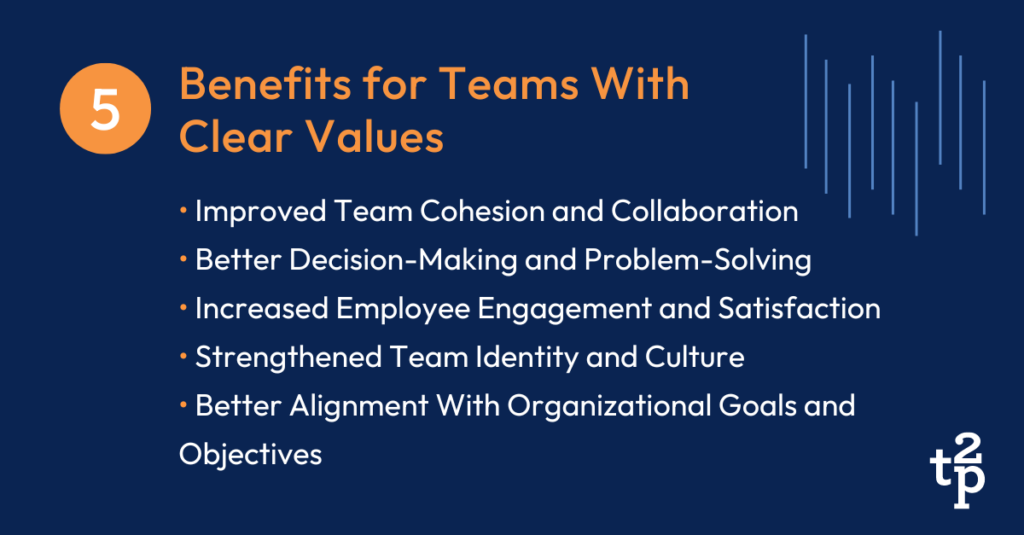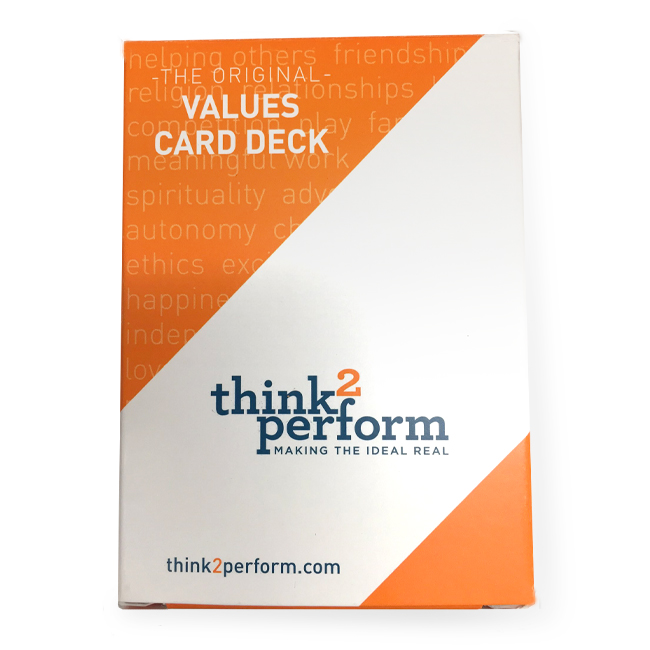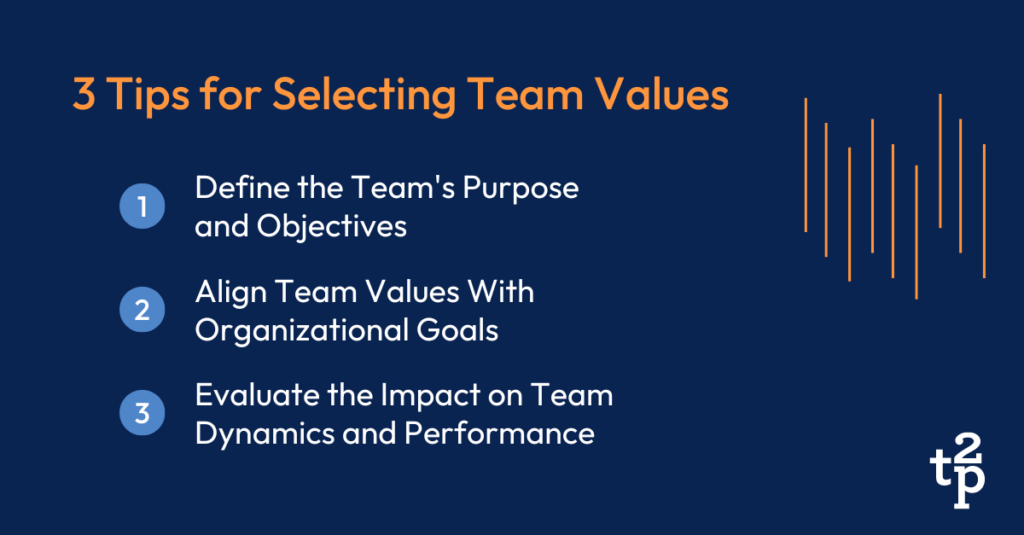What do we mean when we talk about values in the workplace? Sometimes we mean personal values — what’s most important to you and drives your behaviors. There are also organizational values, which leaders use to drive culture, achieve goals and create differentiation. But teams perform most of the work inside organizations, leading to the obvious question: What are team values?
It turns out that team values are a decisive factor between top-performing and mediocre organizations. Star individuals, of course, are essential. But the teams with shared values will regularly outperform disparate individuals, according to research highlighted in Harvard Business Review. These teams also tend to be diverse in their abilities, backgrounds and ways of thinking.
These teams use their values as a North Star to align their thinking and behaviors. They collaborate closely even while working through conflict and dealing with adversity. The foundational challenge for leaders, then, is to define their team’s values, assess the current state and work to close the gap.
Learn more about what team values look like, how you can develop them in your team and why they matter.

Benefits for Teams With Clear Values
Living in alignment is about matching your values with your behaviors. This applies to teams, too, not just individuals. Here are some of the benefits for teams that declare their values and put them into practice.
Improved Team Cohesion and Collaboration
Determining team values gives everyone a common framework for understanding and relating to each other. Team members don’t have to personally resonate with each team value, but they agree that these values matter for the collective.
This shared understanding helps to build trust, respect and empathy. Team members are more willing to work together, and collaboration goes more smoothly because of this shared understanding, which informs shared goals.
Shared values also can help team members decide that they aren’t a fit because of a values mismatch. Leaders can work to help them find a better opportunity, improving team cohesion and helping the employee contribute more fully elsewhere.
Better Decision-Making and Problem-Solving
Teams with clear values have a solid foundation for making decisions and solving problems. When values are clearly defined, they serve as guiding principles, especially in high-pressure situations.
Values can ground teams by giving them an outlet to step back when emotionally engaged. Our emotions are part of who we are, but they can prevent us from making logical decisions under stress. It’s too easy for teams and individuals to make poor, even unethical decisions, as they react to the situation. By appealing to shared values, teams can remember their purpose and realign themselves with their values, organizational goals and other priorities.
Increased Employee Engagement and Satisfaction
Employees want to feel like they belong to something meaningful and important. Clear team values contribute to this, which can improve employee engagement and satisfaction.
As our State of the Values report found,
- People value people.
- People value making a difference.
- People value doing things the right way…and being rewarded for it.
Values help in all three areas. Shared team values help employees feel connected to their teammates. Because the team can collaborate and problem-solve more effectively, employees see their productivity and impact increase — they’re making more of a difference.
And in organizational cultures that reward values-driven behaviors, team members understand that when they do things the right way, they’ll be rewarded for it. They’ll gain a sense of purpose that motivates them to actively contribute their skills and expertise.
Strengthened Team Identity and Culture
One definition of “culture” is the shared values, ideas and behaviors that define a group. When you declare values within a team, you influence a culture all employees can get on board with. Moreover, they’ll see their purpose as tied to those values, rather than viewing themselves as somewhat random employees within an organization.
Every team and organization has a culture. Team values help leaders shape that culture instead of letting a culture form through neglect.
Better Alignment With Organizational Goals and Objectives
Team values ultimately must align with larger organizational values and goals. But many teams might feel uncertain about how their activities support the overall organization — think support staff, or job roles not directly tied to revenue or the organization’s core products and services.
For those teams, clear values are even more important, as they can inform the team’s behaviors and provide a road map to how those actions support the organization. With team values, your people focus on the right things and gain a greater sense of mission and purpose.

Getting Started With Team Values
Because great teams aren’t monoliths, leaders will have a collection of people with many different perspectives, opinions, and ways of thinking and working. That can make for growing pains in new teams and even create conflict within poorly managed teams.
But as Microsoft and IDEO research found, forming a collective identity doesn’t require that everyone think identically. When leaders guide their teams to a set of shared values, they can overcome differences or even turn them into strengths. Here are a few ideas for doing so.
Conducting a Team Values Exercise
One effective method for assessing team values is through a team values exercise. This approach allows team members to reflect on their personal values and identify which are most important to them.
This can take numerous forms. The important thing is to provide a space for open and respectful conversations about values — and help everyone better understand what matters most to them and their teammates.
The first step is helping individuals name their values. With think2perform’s Values Card Exercise, each person sorts through the cards (a physical deck or virtually), determining which values are personally important and which aren’t. Think about the “ideal you” and the “real you.” With some people, the real and ideal are closely matched, while other people are out of alignment.
From the initial pile of “important” values, continue paring down the most important until a core set of highest-priority values is determined — for example, top 20 values, then 10, then five.
Identifying Shared Values
When everyone has defined their personal values, you can apply the values exercise for teams. For example, have each employee come to the team values exercise with their five values in hand. See which values are most common among your team and what that might mean for the team’s values.
As you define each shared value, discuss how it affects the team’s work and interactions. Consider which values are aligned with behaviors and which ones aren’t.
This type of exercise helps everyone be clear about what values are most important to the team and which are less vital. By exploring as a group, teams get a wider range of perspectives, learn more about each other and better understand their personal alignment of values and behavior.

Choosing Core Team Values
Once you’ve identified everyone’s individual values, discussed them and found overlap in people’s values, it’s time to choose what your team will stand for. Note that the most popular individual values among the group might not necessarily be the team’s top values — you’ll want to compare those with team objectives and organizational values, for example.
Here are three things to consider when choosing team values.
Define the Team’s Purpose and Objectives
The first step is gaining clarity on the team’s purpose and objectives within the organization. This might be obvious for well-established teams, but it’s a critical step for new teams or ones that have undergone major changes.
This step helps leaders check that the team members understand what they’re supposed to work on and why. If there’s misalignment, take a step back and reiterate the team’s objectives. Work through misconceptions or employee questions, especially if they feel like they can’t fulfill those values. Consider how the purpose might be slightly different based on each employee’s job role, responsibilities and skill set.
Once everyone is aligned on their goals and purpose, consider which values can best guide the team’s actions, decision-making processes and interactions. For example, a consulting team might embrace values such as “cooperation” or “teamwork,” as their work explicitly requires them to work closely internally and with clients. A design team at an advertising agency, meanwhile, might embrace qualities such as “play” or “diversity” given the highly creative, innovative and inclusive nature of their work.
Align Team Values With Organizational Goals
Identify the organization’s strategic goals, mission and culture. Ultimately, the team must align with and support the broader organization. The values your team chooses should help everyone make values-based decisions in the flow of work.
With goals and values in hand, compare and contrast them against the pool of team values you’re considering. Consider how the team’s values can align with and support the organization’s goals. Identify the values that will help the team make meaningful contributions toward the organization’s mission and objectives.
Where is there obvious alignment? Where might team values come into conflict with organizational goals and need modification?
For example, a quality control team is all about preventing product errors and defects. Its values might include “safety,” “zero mistakes” and “thoroughness,” but one of the organization’s top values is to be decisive — a first mover that ships products and fixes them later. The quality control team will need to determine what its values mean in that context.
Additionally, the team could focus on values such as “integrity” and “ethics,” which can align the team on pursuing excellence and upholding standards while still supporting the organization’s desire to move quickly.
Evaluate the Impact on Team Dynamics and Performance
Values shape team behavior, communication and collaboration. Consider how team values will impact interpersonal dynamics and performance — especially if the values are a departure from the previous perception of the team’s goals and beliefs.
Consider a “pre-mortem,” or a discussion of how the chosen team values could lead to challenges, conflict or negative outcomes. Understand that team members might need time to absorb the new values and apply them to daily behaviors, especially if the values are new to them or aren’t among their most important personal values.
Instilling and Living Team Values
Identifying and adopting values is important work but insufficient. The next phase is to help your team absorb these values and live them in their everyday behaviors. This process will require ongoing communication, coaching and modeling by leaders to instill values as a habit, rather than a box to check off.
Communicate and Reinforce Team Values
Communication is essential to ensure that every team member knows what the new values are, what they mean and how they apply to everyday situations. Make sure these values are written down and accessible to any employee at any time.
Leaders should regularly reinforce them in teamwide communications and more casual settings. For example, during an important discussion about a project, leaders might prompt everyone to ask how the potential choices align with the team’s values.
Repetition is important, but make sure to add storytelling. Recognize, reward and share stories of team members putting these values into action, and explain leadership decisions in the context of the team’s values. Consistently communicating and reinforcing team values helps everyone make them a tangible part of their work, rather than a values exercise they do once and forget about.
Lead by Example
Team values are meant to align with behaviors. Set the example by focusing on your thoughts, words and actions. Do your behaviors align with team values? Do you reinforce them in your interactions with employees, or do you inadvertently give them permission to disregard the values.
Leading by example helps team members feel like the values matter. Over time, they’ll be motivated to live the values in their daily work and hold their peers accountable for doing the same.
Periodically Audit Team Values
Values can change over time because people change. The same goes for teams. By periodically auditing team values, teams can ensure that they remain a guiding force in their daily work.
Conduct informal check-ins to assess how well team members are living the values. Do they understand what the values mean or how to apply them? Do the team’s values create conflict with other values, such as those of the organization or of other teams?
Seek feedback from team members about the effectiveness of your values and how they could be improved. Periodically, or after major changes, reconvene the team to reassess the team values and whether they make sense for current conditions.
Define Team Values to Fuel Organizational Success
Asking “What are team values?” doesn’t have to be scary. Your team members likely have a good sense of what they value and what they see rewarded within the organization. The challenge is to methodically examine those values, determine which values for the team make sense, and help everyone align their behaviors accordingly. Looking to define your personal and team values? Try our Values Card Exercise.



